Last updated: August 16, 2024
Article
Climate and Water Monitoring at Pecos National Historical Park: Water Year 2023
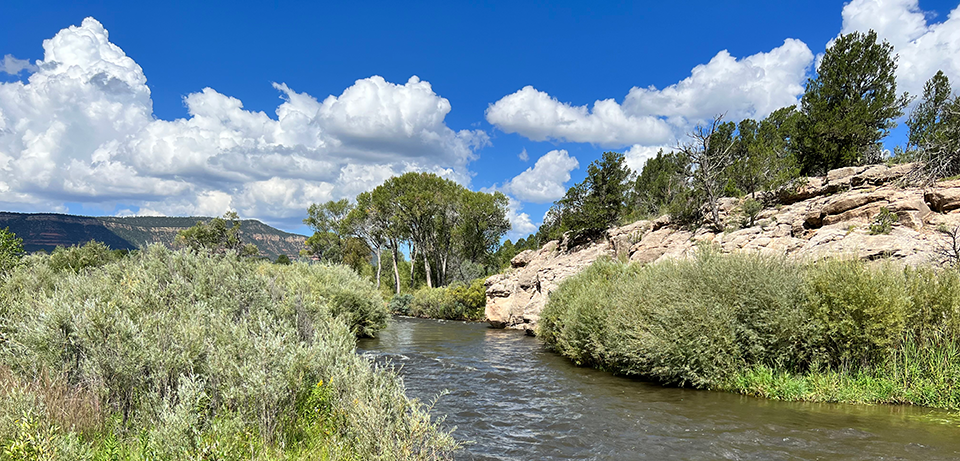
NPS
Overview
Together, climate and hydrology shape ecosystems and the services they provide, particularly in arid and semi-arid ecosystems and across the Southern Plains (Woodhouse and Overpeck 1998). Understanding changes in climate, groundwater, and surface water is key to assessing the condition of park natural resources—and often, cultural resources.
At Pecos National Historical Park (Figure 1), Southern Plains Inventory and Monitoring Network scientists study how ecosystems may be changing by taking measurements of key resources, or “vital signs,” year after year—much as a doctor keeps track of a patient’s vital signs. This long-term ecological monitoring provides early warning of potential problems, allowing managers to mitigate them before they become worse. At Pecos National Historical Park, we monitor climate and groundwater, among other vital signs.
Groundwater conditions are closely related to climate conditions. Because they are better understood together, we report on climate in conjunction with water resources. Reporting is by water year (WY), which begins in October of the previous calendar year and goes through September of the water year (e.g., WY2023 runs from October 2022 through September 2023). This article reports the results of climate and groundwater monitoring at Pecos National Historical Park in WY2023.
Reference: Woodhouse, C. A., and J. T. Overpeck. 1998. 2000 years of drought variability in the central United States. Bulletin of the American Meteorological Society 79(12): 2693–2714. https://doi.org/10.1175/1520-0477(1998)079%3C2693:YODVIT%3E2.0.CO;2.
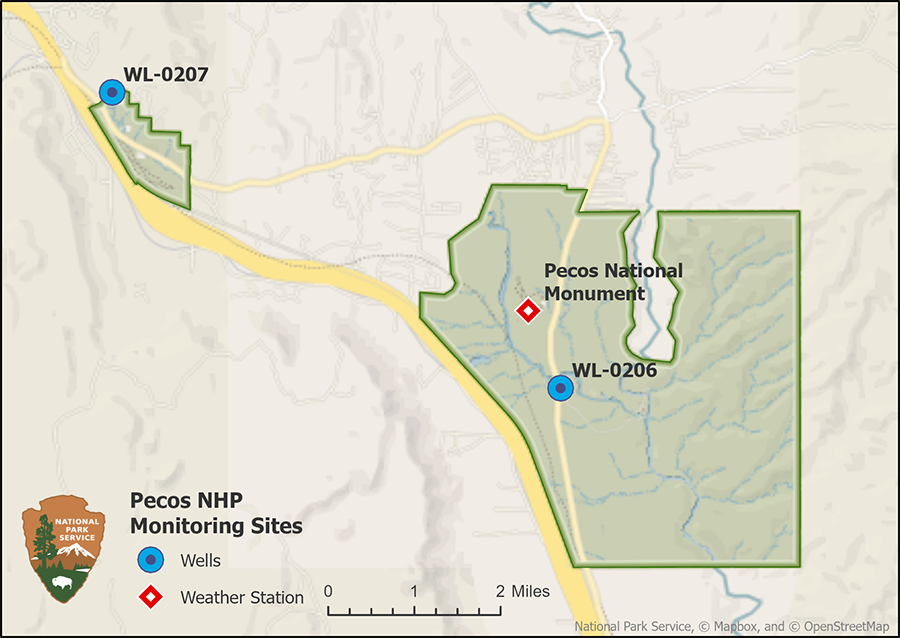
NPS
Climate and Weather
There is often confusion over the terms “weather” and “climate.” In short, weather describes instantaneous meteorological conditions (e.g., it’s currently raining or snowing, it’s a hot or frigid day). Climate reflects patterns of weather at a given place over longer periods of time (seasons to years). Climate is the primary driver of ecological processes on earth. Climate and weather information provide context for understanding the status or condition of other park resources.
Methods
A National Oceanic and Atmospheric Administration Cooperative Observer Program (NOAA COOP) weather station (Pecos National Monument #296676) has been operational at Pecos National Historical Park since 1916 (Figure 1). This station typically provides a reliable climate dataset. However, in WY2023 the station was missing data for 208 days. As a substitute, climate analyses in this report use 30-year averages (1991–2020) and gridded surface meteorological (GRIDMET) data from the location of the COOP station. Subsequent reports may revert to the weather stations as the data source depending on future data quality.
GRIDMET is a spatial climate dataset at a 4-kilometer resolution that is interpolated using weather station data, topography, and other observational and modeled land surface data. Temperature and precipitation estimated from GRIDMET may vary from actual weather at a particular location depending on the availability of weather station data and the difference in elevation between the location of interest and that assigned to a grid cell. Data from both weather station and GRIDMET are accessible through Climate Analyzer.

NPS
Results for Water Year 2023
Precipitation
Annual precipitation at Pecos National Historical Park in WY2023 was 16.75″ (42.5 cm), 0.66″ (1.7 cm) more than the 1991–2020 annual average. Precipitation totals in October, January, February, March, and June were substantially higher than the 1991–2020 average by 58–172% (Figure 2). These surpluses were balanced out by substantially drier than average conditions in November, December, April, July and September. While the monsoon started off strong in June, the rest of the monsoon season (July–September) was drier than average, resulting in 9.31″ of rainfall in total, 2.74″ less than the 1991–2020 average for the season.
Air Temperature
The mean annual maximum temperature in WY2023 was 64.2°F (17.9°C), 1.5°F (0.8°C) below the 1991–2020 average. The mean annual minimum temperature in WY2023 was 34.3°F (1.3°C); a temperature that was comparable to the 1991–2020 average. Mean monthly maximum and minimum temperatures in WY2023 differed by as much as 7.3°F (4.1°C; see March as an example) relative to the 1991–2020 monthly averages (Figure 2). Mean monthly maximum and minimum temperatures in WY2023 were generally cooler than the 1991–2020 averages from October–June and warmer than average between July and September.
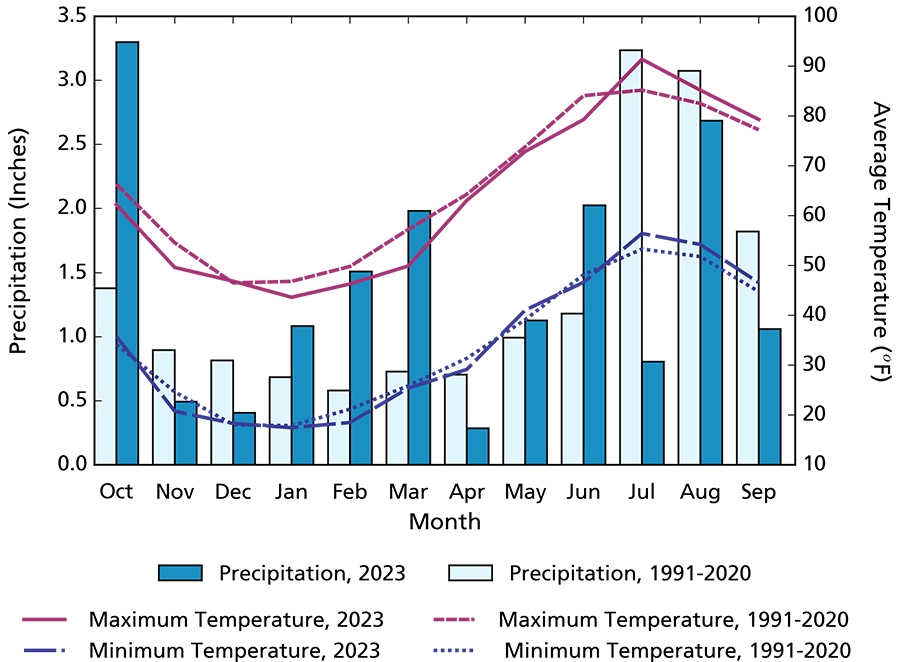
NPS
Drought
Reconnaissance drought index (Tsakiris and Vangelis 2005) provides a measure of drought severity and extent relative to the long-term climate. It is based on the ratio of average precipitation to average potential evapotranspiration (the amount of water loss that would occur from evaporation and plant transpiration if the water supply was unlimited) over short periods of time (seasons to years). The reconnaissance drought index for Pecos National Historical Park indicates that WY2023 was slightly wetter than the 1991–2023 average for the second consecutive year from the perspective of both precipitation and potential evapotranspiration (Figure 3).
Reference: Tsakiris G., and H. Vangelis. 2005. Establishing a drought index incorporating evapotranspiration. European Water 9: 3–11.
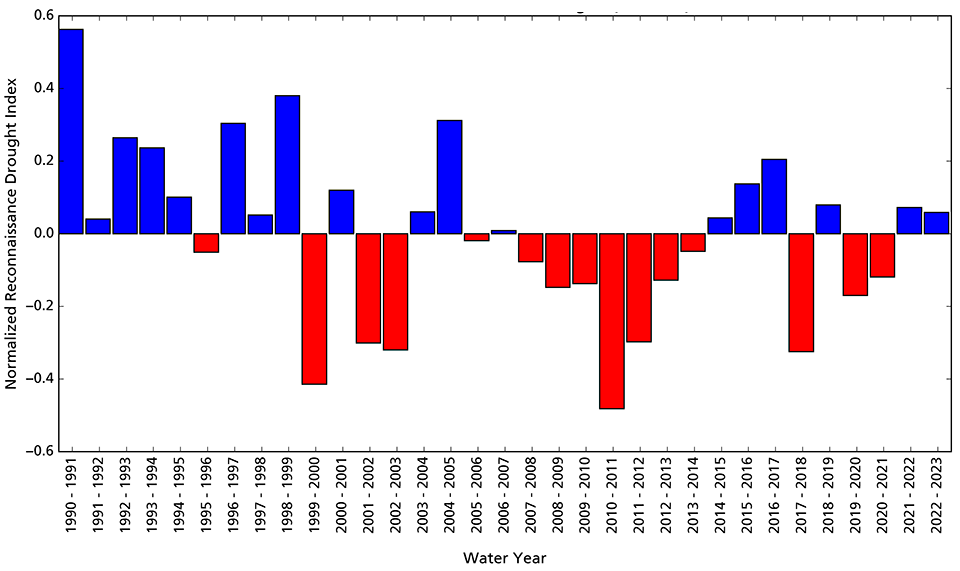
NPS

NPS
Groundwater
Groundwater is one of the most critical natural resources of the American Southwest, providing drinking water, irrigating crops, and sustaining rivers, streams, and springs throughout the region.
Methods
Pecos National Historical Park groundwater is monitored in two wells (Figure 1). The New Mexico Bureau of Geology and Mineral Resources began monitoring both wells in 2020. The well at the trading post (WL-0206) is monitored continuously, and the well at the Glorieta Battlefield Trail (WL-0207) is monitored annually. The data are available at the Healy Collaborative Groundwater Monitoring Network.
Results of Water Year 2023
Groundwater levels in WY2023 were stable and relatively shallow (Table 1 and Figure 4). The mean depth to water at WL-0206 was 41.42 feet below ground surface (ft bgs; 12.62 m bgs), slightly higher than the previous water year; however, data after 24 August 2023 are not available, so the mean is based on a partial water year. The continuous depth-to-water measurements at WL-0206 include measurements recorded when the well was pumping, which can cause temporary decreases in water level of up to 20 ft. Therefore, static depth to water at WL-0206 was likely slightly higher than the WY2023 mean. The water level in WL-0207 was slightly lower than the previous measurement.
Table 1. Groundwater monitoring results in water year 2023 (WY2023), Pecos National Historical Park (amsl = above mean sea level; bgs = below ground surface).
| State Well Number | Location | Wellhead Elevation (ft amsl) |
Mean Depth to Water (ft bgs) |
Mean Water Level Elevation (ft amsl) |
Change in Elevation from WY2022 (± ft) |
|---|---|---|---|---|---|
| WL-0206 | Trading Post | 6,833.00 | 41.42* | 6,791.58 | +0.27 |
| WL-0207 | Glorieta Battlefield Trail | 7,330.00 | 34.13 | 7,295.87 | −0.29 |
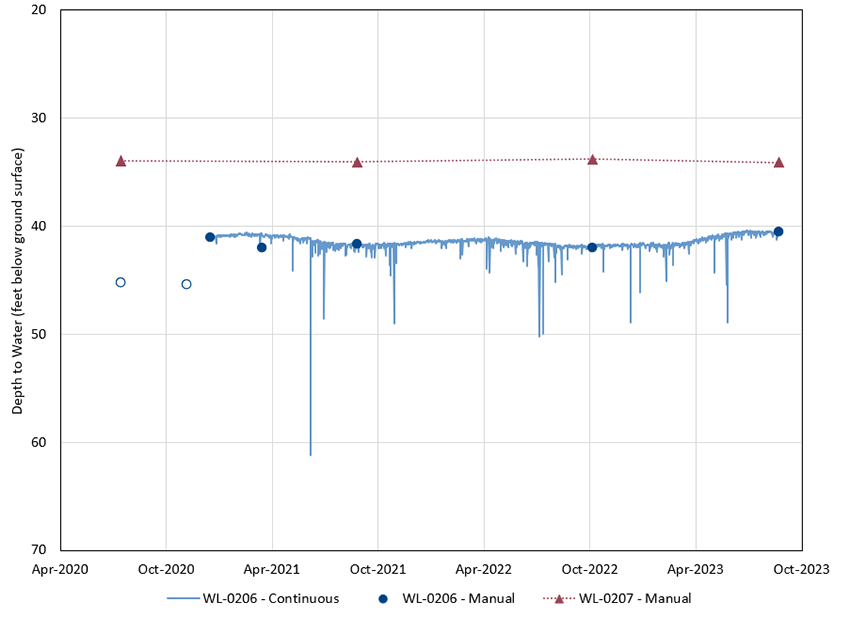
NPS
